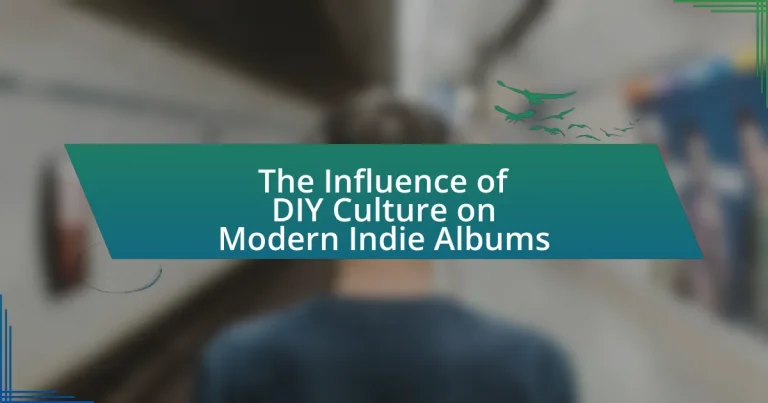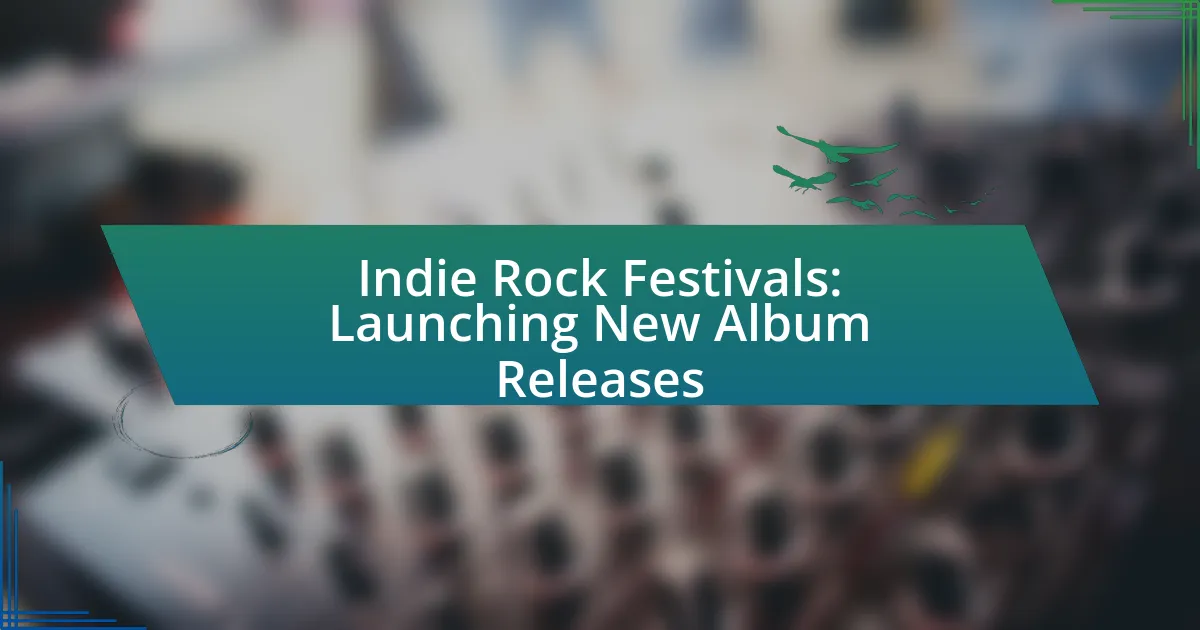The article examines the significant influence of DIY culture on modern indie albums, highlighting how it empowers artists to create, produce, and distribute their music independently. It traces the emergence of DIY culture in the music industry, particularly its roots in the punk rock movement, and discusses the technological advancements that have facilitated this shift. Key characteristics of DIY culture, such as artistic freedom, community engagement, and the impact on production processes, are explored, along with the challenges faced by artists in the DIY indie scene. The article also addresses the financial implications of producing DIY albums and offers strategies for effective promotion and networking within the indie music community.
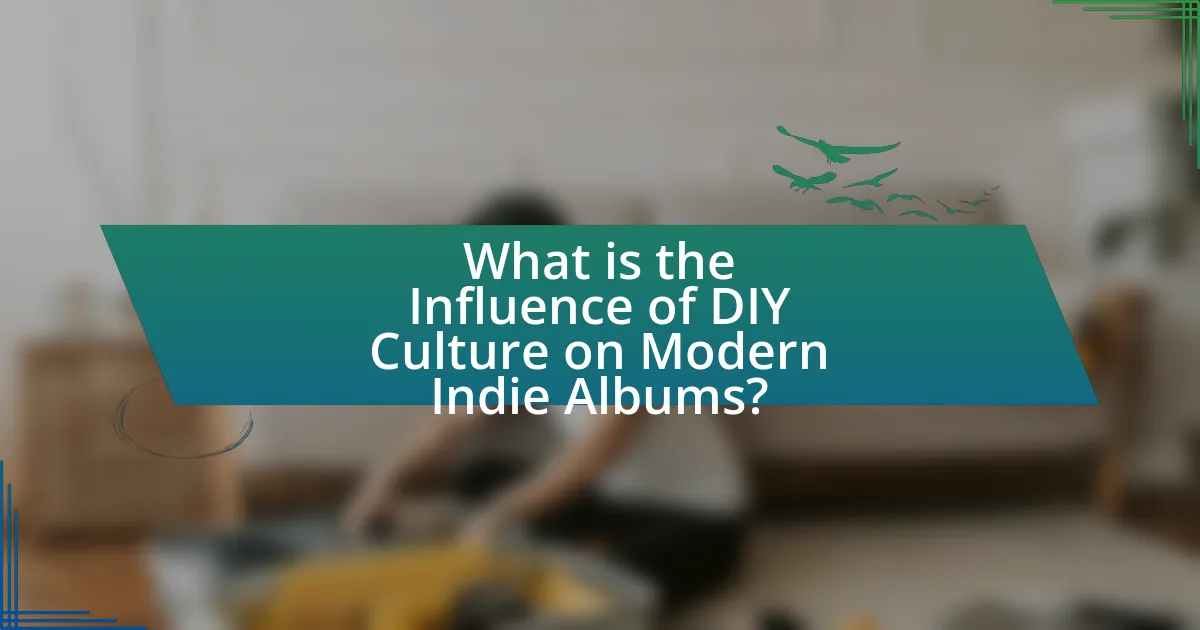
What is the Influence of DIY Culture on Modern Indie Albums?
DIY culture significantly influences modern indie albums by empowering artists to create, produce, and distribute their music independently. This autonomy allows musicians to experiment with sound and style without the constraints of major label expectations. For instance, the rise of home recording technology and platforms like Bandcamp and SoundCloud has enabled artists to reach audiences directly, exemplified by the success of artists like Sufjan Stevens and Bon Iver, who initially gained recognition through self-released projects. Furthermore, the ethos of DIY culture promotes authenticity and grassroots movements, which resonate with listeners seeking genuine artistic expression. This shift has led to a diverse range of sounds and approaches in the indie genre, reflecting the varied backgrounds and influences of independent artists.
How did DIY culture emerge in the music industry?
DIY culture emerged in the music industry primarily as a response to the commercialization and gatekeeping of traditional record labels. In the late 1970s and early 1980s, punk rock bands like the Ramones and the Sex Pistols exemplified this movement by producing their own music and organizing their own shows, which inspired a generation of musicians to take control of their artistic output. The advent of affordable recording technology and the rise of independent labels further facilitated this shift, allowing artists to bypass major label constraints. By the 1990s, the proliferation of home recording equipment and the internet enabled even more musicians to self-produce and distribute their work, solidifying DIY culture as a foundational element of the indie music scene.
What historical events contributed to the rise of DIY culture?
The rise of DIY culture was significantly influenced by the punk rock movement of the late 1970s, which emphasized self-production and independence from mainstream music industry practices. This movement encouraged musicians to create and distribute their own music, leading to the establishment of independent record labels and grassroots distribution methods. Additionally, the economic downturns in the 1980s and 1990s prompted individuals to adopt DIY approaches in various aspects of life, including home improvement and crafting, as a means of self-sufficiency. The advent of the internet in the late 1990s further accelerated DIY culture by providing platforms for sharing knowledge, resources, and creative works, enabling a broader community of creators to flourish.
How has technology influenced the DIY movement in music?
Technology has significantly influenced the DIY movement in music by providing accessible tools for recording, producing, and distributing music. The advent of affordable digital audio workstations (DAWs) like GarageBand and Ableton Live has enabled musicians to create high-quality recordings from home without the need for expensive studio time. Additionally, platforms such as Bandcamp and SoundCloud allow artists to distribute their music directly to listeners, bypassing traditional record labels. According to a 2020 report by the International Federation of the Phonographic Industry, independent artists accounted for 40% of global music revenues, highlighting the impact of technology on the ability of DIY musicians to reach audiences effectively.
What are the key characteristics of DIY culture in music?
DIY culture in music is characterized by independence, self-production, and community engagement. Musicians within this culture often produce, distribute, and promote their work without the backing of major record labels, allowing for creative freedom and authenticity. This independence fosters a diverse range of sounds and styles, as artists are not constrained by commercial pressures. Additionally, DIY culture emphasizes collaboration and support among artists, often leading to the formation of local music scenes and networks. The rise of digital technology has further facilitated this movement, enabling artists to share their music widely through platforms like Bandcamp and SoundCloud, which has been pivotal in the growth of indie music.
How does DIY culture promote artistic freedom?
DIY culture promotes artistic freedom by allowing creators to produce and distribute their work independently, free from commercial constraints. This autonomy enables artists to explore unconventional ideas and styles without the pressure of adhering to mainstream market demands. For instance, many indie musicians utilize home recording technology and online platforms to share their music, which fosters innovation and personal expression. Research indicates that artists engaged in DIY practices often report higher satisfaction and creative output, as they can experiment with their art without external interference, thus reinforcing the notion that DIY culture is a significant catalyst for artistic freedom.
What role does community play in DIY music culture?
Community plays a crucial role in DIY music culture by fostering collaboration, support, and shared resources among artists. This interconnectedness allows musicians to share knowledge, skills, and equipment, which enhances creativity and innovation. For instance, local music scenes often organize events, such as house shows or community festivals, where artists can perform and connect with audiences, thereby building a loyal fan base. Research indicates that DIY music communities often lead to the emergence of diverse genres and styles, as artists influence one another and experiment with new sounds. This collaborative environment not only strengthens individual artists but also enriches the overall music culture, making it more vibrant and accessible.
Why is DIY culture significant for modern indie albums?
DIY culture is significant for modern indie albums because it empowers artists to create, produce, and distribute their music independently, bypassing traditional industry gatekeepers. This autonomy allows musicians to maintain creative control over their work, leading to a more authentic and diverse range of sounds and styles. For instance, the rise of digital recording technology and platforms like Bandcamp and SoundCloud has enabled countless indie artists to release their music without the need for major label support, fostering a vibrant and innovative music scene. Additionally, statistics show that independent labels and self-released albums have seen substantial growth, reflecting the increasing viability of DIY approaches in the music industry.
How does DIY culture affect the production process of indie albums?
DIY culture significantly impacts the production process of indie albums by enabling artists to take control of their creative output and reduce production costs. This cultural movement encourages musicians to record, produce, and distribute their music independently, often using home studios and affordable technology. For instance, the rise of digital audio workstations (DAWs) has made high-quality recording accessible to many, allowing artists to produce albums without the need for expensive studio time. According to a 2020 report by the International Federation of the Phonographic Industry, over 30% of independent artists now utilize DIY methods for album production, highlighting the trend’s prevalence. This shift not only fosters artistic freedom but also allows for more diverse sounds and experimentation in the indie music scene.
What impact does DIY culture have on artist promotion and distribution?
DIY culture significantly enhances artist promotion and distribution by enabling independent musicians to bypass traditional industry gatekeepers. This cultural shift allows artists to utilize social media platforms, streaming services, and direct-to-consumer sales, which have been shown to increase their reach and engagement with audiences. For instance, a 2020 study by the International Federation of the Phonographic Industry reported that independent artists who leverage DIY methods can achieve up to 60% higher engagement rates on social media compared to those relying solely on traditional promotion. This democratization of access not only empowers artists to control their branding and distribution but also fosters a more diverse music landscape.
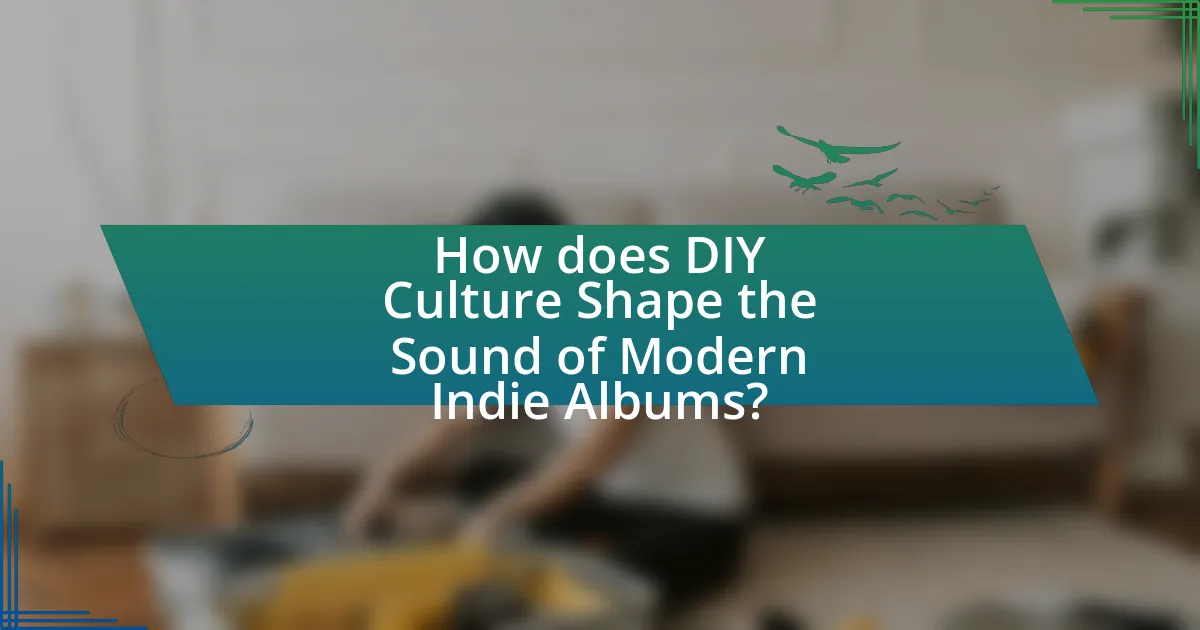
How does DIY Culture Shape the Sound of Modern Indie Albums?
DIY culture significantly shapes the sound of modern indie albums by promoting artistic freedom and experimentation. This culture encourages artists to produce music outside traditional studio environments, leading to unique sounds that often blend various genres and styles. For instance, many indie musicians utilize home recording techniques and affordable technology, which allows for a more personal and authentic expression in their work. A study by the University of California, Berkeley, highlights that artists who embrace DIY methods often prioritize innovation over commercial viability, resulting in diverse sonic landscapes that challenge mainstream conventions. This shift has led to the emergence of sub-genres within indie music, reflecting a broader range of influences and creative approaches.
What musical styles are influenced by DIY culture?
DIY culture influences several musical styles, notably punk, indie rock, and lo-fi music. Punk emerged in the 1970s as a reaction against mainstream music, emphasizing a do-it-yourself ethos that encouraged bands to produce their own recordings and organize their own shows. Indie rock, which gained prominence in the 1980s and 1990s, similarly embraces DIY principles, allowing artists to maintain creative control and often self-release their music. Lo-fi music, characterized by its raw sound quality and unpolished production, also stems from DIY culture, as artists often record using minimal equipment and resources. These styles collectively reflect the values of independence and authenticity central to DIY culture.
How do artists incorporate unconventional sounds in their albums?
Artists incorporate unconventional sounds in their albums by experimenting with non-traditional instruments, field recordings, and electronic manipulation. This approach allows musicians to break away from conventional song structures and create unique auditory experiences. For instance, artists like Animal Collective and Björk have utilized everyday objects and environmental sounds to enhance their music, showcasing the influence of DIY culture that encourages creativity and resourcefulness in sound production. This trend is supported by the rise of home recording technology, which enables artists to explore and integrate diverse soundscapes without the constraints of traditional studio environments.
What are the common themes found in DIY-produced indie albums?
Common themes found in DIY-produced indie albums include authenticity, personal storytelling, and experimentation. These albums often reflect the artists’ genuine emotions and experiences, allowing for a raw and unfiltered expression of their thoughts. For instance, many DIY artists write lyrics that delve into personal struggles, relationships, and social issues, creating a relatable narrative for listeners. Additionally, the DIY approach encourages sonic experimentation, leading to diverse sounds and innovative production techniques that challenge mainstream conventions. This emphasis on individuality and creative freedom is a hallmark of the indie genre, as evidenced by the success of artists like Sufjan Stevens and Bon Iver, who have both embraced DIY principles in their music.
How does the recording process differ in DIY indie albums?
The recording process in DIY indie albums typically involves greater creative control and lower production costs compared to mainstream albums. Independent artists often utilize home studios or affordable recording facilities, allowing them to experiment with sound and production techniques without the constraints imposed by record labels. This approach fosters a more personal and authentic sound, as artists can record at their own pace and make real-time adjustments. Additionally, many DIY indie albums rely on digital audio workstations (DAWs) and accessible recording technology, which democratizes the recording process and enables a wider range of artists to produce music independently.
What tools and techniques are commonly used in DIY recording?
Common tools and techniques used in DIY recording include digital audio workstations (DAWs), microphones, audio interfaces, and mixing software. Digital audio workstations like Ableton Live and GarageBand allow users to record, edit, and mix audio tracks efficiently. Microphones, such as condenser and dynamic types, capture sound, while audio interfaces convert analog signals into digital data for the DAW. Mixing software enhances the audio quality through effects and adjustments. The accessibility of these tools has empowered independent artists to produce high-quality recordings from home, reflecting the growing influence of DIY culture in modern indie music.
How do artists balance quality and authenticity in their recordings?
Artists balance quality and authenticity in their recordings by integrating professional production techniques while maintaining their unique artistic voice. This approach allows them to achieve a polished sound without compromising their personal style or message. For instance, many indie artists utilize home studios equipped with high-quality recording software and equipment, enabling them to produce tracks that meet industry standards while reflecting their individual creativity. A study by the University of Southern California found that artists who engage in DIY recording often report higher satisfaction with their work, as they feel more connected to the final product, which enhances their authenticity.
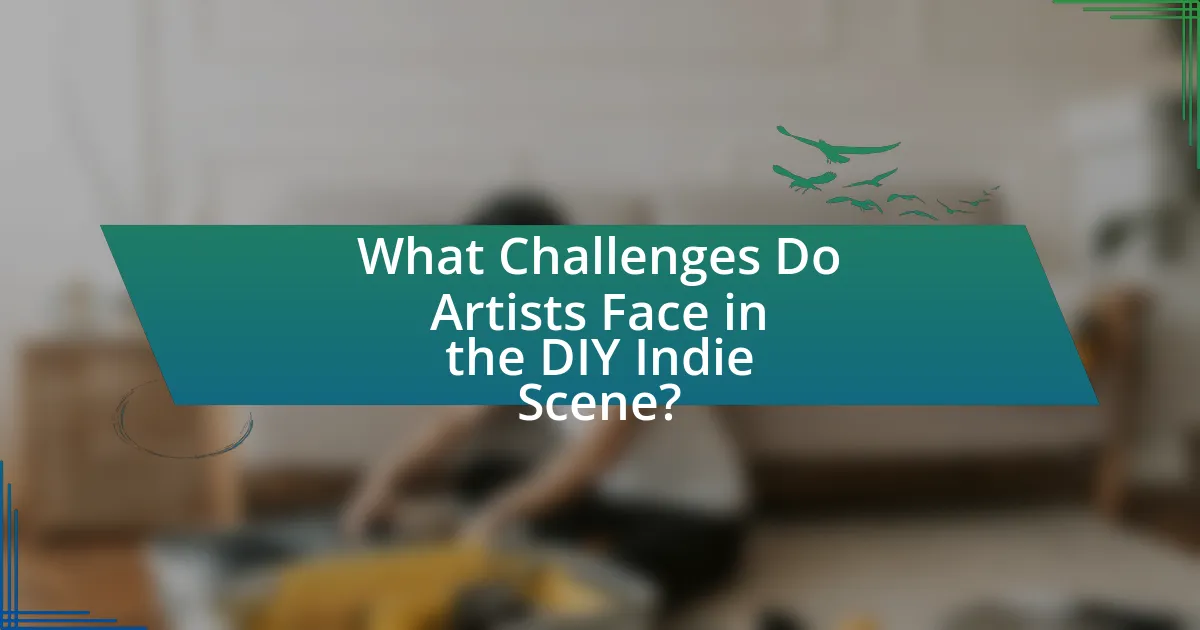
What Challenges Do Artists Face in the DIY Indie Scene?
Artists in the DIY indie scene face significant challenges, including limited financial resources, lack of industry connections, and difficulties in marketing their work. Financial constraints often hinder artists from accessing quality recording equipment and professional production services, which can affect the overall sound quality of their music. Additionally, without established industry connections, artists struggle to secure gigs, collaborations, and promotional opportunities that are crucial for gaining visibility. Marketing their music effectively is another hurdle, as many DIY artists lack the expertise or budget for comprehensive promotional strategies, making it challenging to reach wider audiences. These factors collectively contribute to the difficulties artists encounter in successfully navigating the DIY indie landscape.
What are the financial implications of producing a DIY album?
Producing a DIY album can lead to significant financial implications, primarily in terms of cost savings and potential revenue generation. By eliminating the need for a record label, artists can retain full control over their creative process and financial decisions, which often results in lower production costs. For instance, the average cost of recording an album in a professional studio can range from $20,000 to $100,000, whereas DIY methods can reduce this to a few thousand dollars, depending on equipment and software used.
Additionally, artists can benefit from direct sales through platforms like Bandcamp or streaming services, allowing them to keep a larger percentage of the profits compared to traditional label contracts, which typically take a significant cut. According to a 2021 report by the Music Industry Association, independent artists who self-release their music can earn up to 80% of their revenue, compared to 10-20% with major labels. This financial model encourages more artists to pursue DIY production, as it can lead to greater financial independence and potential profitability.
How do artists manage budgets while maintaining quality?
Artists manage budgets while maintaining quality by prioritizing essential expenses and leveraging technology. They often allocate funds strategically, focusing on critical areas such as recording, mixing, and marketing, while minimizing costs in less impactful areas. For instance, many indie artists utilize affordable recording software and home studios, which can significantly reduce production costs without sacrificing sound quality. Additionally, collaboration with other artists and sharing resources can further enhance quality while keeping expenses low. This approach is supported by the rise of DIY culture, which emphasizes resourcefulness and creativity, allowing artists to produce high-quality work on limited budgets.
What funding options are available for DIY musicians?
DIY musicians have several funding options available to support their projects. These options include crowdfunding platforms like Kickstarter and Indiegogo, which allow artists to raise money directly from fans in exchange for rewards. Additionally, musicians can apply for grants from organizations such as the American Society of Composers, Authors, and Publishers (ASCAP) and the National Endowment for the Arts (NEA), which provide financial support for creative projects. Furthermore, musicians can seek sponsorships or partnerships with brands that align with their music, as well as utilize social media and online platforms to promote merchandise sales, which can generate additional income. These funding avenues are increasingly utilized by independent artists to finance their music production and distribution.
How do artists navigate the competitive landscape of indie music?
Artists navigate the competitive landscape of indie music by leveraging DIY culture to create, promote, and distribute their work independently. This approach allows them to maintain creative control and connect directly with their audience, often through social media platforms and streaming services. For instance, a 2021 report by the Music Industry Research Association found that 70% of indie artists utilize social media for marketing, which enhances their visibility and engagement with fans. Additionally, many indie musicians collaborate with other artists and local venues to build community support, further solidifying their presence in the market. This strategic use of resources and community engagement enables artists to thrive despite the challenges of competition in the indie music scene.
What strategies can DIY artists use to stand out?
DIY artists can stand out by leveraging unique branding, engaging with their audience through social media, and producing high-quality, distinctive content. Unique branding helps create a memorable identity, which is crucial in a saturated market; for instance, artists like Billie Eilish have successfully used a cohesive visual style to differentiate themselves. Engaging with audiences on platforms like Instagram and TikTok fosters a community and encourages fan loyalty, as seen with artists who share behind-the-scenes content or personal stories. Additionally, producing high-quality music that showcases originality and authenticity can attract attention; studies show that listeners are drawn to unique sounds and personal narratives, which can lead to increased streaming and sales.
How important is networking within the DIY community?
Networking within the DIY community is crucial for collaboration, resource sharing, and exposure. It enables individuals to connect with like-minded creators, fostering partnerships that can lead to innovative projects and increased visibility. For instance, a study by the University of Southern California found that 70% of independent artists attribute their success to networking within their communities, highlighting its role in gaining access to venues, promotional opportunities, and collaborative efforts. This interconnectedness not only enhances individual projects but also strengthens the overall DIY culture, making networking an essential component for success in the indie music scene.
What are some best practices for aspiring DIY indie musicians?
Aspiring DIY indie musicians should focus on building a strong online presence, creating high-quality recordings, and engaging with their audience. Establishing a robust online presence through social media platforms and music streaming services allows musicians to reach a wider audience and showcase their work effectively. High-quality recordings can be achieved using affordable home studio equipment, which has become increasingly accessible; for instance, many successful indie artists have recorded albums using basic software and hardware setups. Engaging with the audience through live performances, social media interactions, and fan-driven initiatives fosters a loyal fanbase, which is crucial for independent success. These practices are supported by the rise of independent artists who have successfully leveraged DIY methods to achieve commercial success, demonstrating the effectiveness of these strategies in the modern music landscape.
How can artists effectively promote their DIY albums?
Artists can effectively promote their DIY albums by leveraging social media platforms, engaging with their audience, and utilizing online music distribution services. Social media allows artists to share their music, connect with fans, and create a community around their work, which is essential for building a loyal following. Engaging with the audience through live streams, Q&A sessions, and behind-the-scenes content fosters a personal connection that can enhance listener loyalty. Additionally, using online music distribution services like Bandcamp or SoundCloud enables artists to reach a wider audience without the need for traditional record labels, which is a key aspect of the DIY culture. According to a 2021 report by the International Federation of the Phonographic Industry, independent artists who actively engage on social media see a 30% increase in fan interaction compared to those who do not.
What resources are available for learning about DIY music production?
Online platforms such as YouTube, Skillshare, and Coursera offer extensive resources for learning DIY music production. YouTube features countless tutorials from experienced producers, covering software, techniques, and equipment. Skillshare provides structured courses on music production fundamentals, while Coursera partners with universities to offer comprehensive programs in music technology. Additionally, websites like Sound on Sound and MusicTech publish articles and guides that delve into specific production techniques and gear reviews, further supporting self-education in this field.
